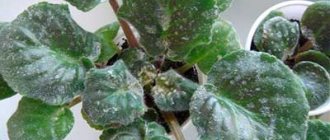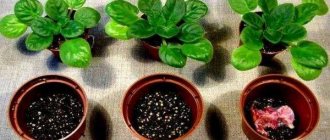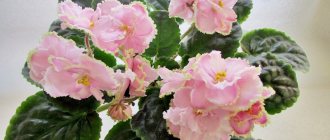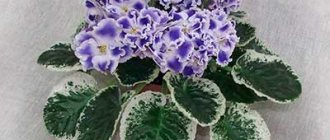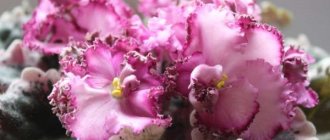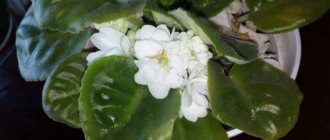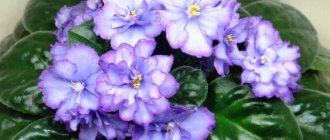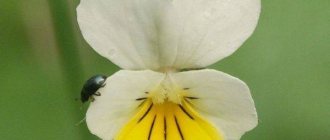SM "Dance of Galaxies" - this is a Usambara violet, which belongs to the Gesnerieceae family.
Saintpaulia got its name for its interesting coloring, reminiscent of vast space . Breeder Konstantin Morev created this bright purple seedling based on the field violet.
In the article you can see SM-Dancing Galaxies photos and descriptions.
Growing rules
Like all violets, “Dance of the Galaxy” is a rather whimsical and capricious variety.
In unfavorable conditions, the plant's leaves quickly turn yellow and it dies. Therefore, it is very important to adhere to the following recommendations
Selecting a location
Violets need a well-lit place. The ideal place would be a slightly shaded window that receives diffused sunlight.
In rooms where there is a lack of natural light, lamps can be used.
The level of air humidity also matters.
If the room is too dry, violets stop flowering.
Important! Violets should not be placed in a place exposed to direct sunlight. Under their influence, the plant develops burns on the leaves and may die.
Choosing a pot
The pot in which the Galaxy Dance violet will grow also plays an important role.
When choosing an unsuitable container, there is a risk that the flower will quickly begin to hurt, flowering will stop, the leaves will begin to turn yellow and rot.
To prevent this from happening, it is important to pay attention to choosing the right pot
First you need to decide on the size of the container. The roots of violets do not grow deeply; they are located closer to the soil surface, because need light and nutrients. Therefore there is no need for deep pots.
In addition, it is very important to consider the size of the plant. Expert opinion
Expert opinion
Nesterova Olga Nikolaevna
Specialist in landscaping, master of landscape design. Indoor floriculture consultant
Violet is one of the few plants that thrives in a cramped pot. For planting a large flower, a pot with a height of about 10 centimeters is suitable. For a medium-sized violet, a pot 7 centimeters high works well. If you plan to plant a young plant or mini-violet, it is recommended to choose a container with a diameter of 5 centimeters.
The diameter of the pot should match its height. Containers that are too wide or deep can cause the death of the flower.
The material from which the pot is made is also important. Most often, the following materials are used to make containers:
Plastic – plastic pots often attract attention with their bright colors and cute shapes. However, a plastic pot is not the best option for violets. The paint used to paint the pot contains substances that have a detrimental effect on the root system of the flower.
Because plastic prevents the flow of air; when planting violets in such a pot, it is necessary to make drainage holes. This will avoid rotting of the root system;
Clay - violets feel quite comfortable in clay pots, because... clay is a natural material that is highly permeable to air and moisture. However, clay pots are often quite fragile. Fired clay pots are more reliable because... When exposed to high temperatures, a clay product gains strength. Ceramic pots are also a good option because... ceramics is the same clay that has undergone heat treatment. Such pots can be coated with a special glaze that prevents air from entering. Pots that are not glazed may crack and crumble over time, and in addition, stains from water and salts become visible on them. Despite this, violets do well in ceramic pots that are not glazed.
Soil selection
The soil for violets, including the “Dance of the Galaxy” variety, must be enriched with the necessary nutrients. The soil must be well-permeable to oxygen to prevent rotting of the root system.
Watering
It is recommended to water the violet with settled water, the temperature of which is no more than 25 degrees.
It is allowed to pour water into the pan to keep the soil well moistened.
The “Dance of Galaxies” violet loves humidity, so it is advisable to periodically spray the flower with water from a spray bottle.
Important! Watering a plant with too cold or warm tap water can lead to disease and death of the flower.
Temperature
For good growth and flowering, violets require a room temperature not exceeding 22 degrees.
Slight fluctuations in temperature are allowed, but it is important that the thermometer mark does not fall below 18 degrees
Feeding
If the soil is properly selected, there is no need to feed the violet immediately after planting. During the flowering period, the plant needs fertilizer enriched with potassium and nitrogen.
Blooming violets should be fertilized twice a month. After the flowering period, it is enough to feed the plant once a month.
This is interesting: Household block with woodshed: purpose and design features
Violet "Kira": description and cultivation
Saintpaulia belongs to the Gesneriev family. This plant is popular with many gardeners due to its lush flowering and high decorative value. It is often called violet, although Saintpaulia does not belong to the Violet family. There is only external similarity. This article discusses the description of the Saintpaulia variety “Kira”. For the convenience of the reader, the word “violet” will be used in the text.
Peculiarities
Today there are two varieties of violets with this name. One of them is a plant bred by Elena Lebetskaya. The second is a varietal violet by Dmitry Denisenko
To find out which variety you are purchasing, be sure to pay attention to the prefix in front of the variety name. Many novice flower growers who are just discovering the wonderful world of varietal violets do not know what the capital letters in front of the variety name mean.
Most often these are the initials of the breeder who created this plant (for example, LE - Elena Lebetskaya).
Description of the variety "LE-Kira"
Elena Anatolyevna Lebetskaya is a famous violet breeder from the city of Vinnitsa. Since 2000, she has grown more than three hundred different varieties of this charming plant, such as “LE White Camellia”, “LE Mont Saint Michel”, “Le Scarlett”, “LE Pauline Viardot”, “LE Esmeralda”, “ LE-Fuchsia lace" and many others. It is impossible not to notice Elena Anatolyevna’s violets at exhibitions; they are known in many countries of the world. She always willingly shares the secrets of successfully growing these beautiful flowers with violet lovers in her interviews.
The “LE-Kira” violet with standard sizes was bred by Elena Lebetskaya in 2016. The plant has a medium-sized rosette and large green leaves, slightly wavy at the edges. The flowers are large (single or semi-double), soft pink with a variable white eye. The edges of the petals have a strawberry speckled border. You can also notice a kind of “ruffle” of a greenish color.
The violet blooms profusely. Since this is a variable variety, even on the same plant there can be flowers of different colors.
Conditions and care
This variety of violet grows quickly and forms buds, prefers diffused light 13-14 hours a day. He feels comfortable at a temperature of 19-20 degrees Celsius and does not like drafts. Like all violets, “LE-Kira” needs to be provided with high (not lower than 50 percent) air humidity. Watering should be done with settled water at room temperature. In this case, it is necessary to avoid getting water drops on the leaves and rosette. A young plant should be fed with nitrogen fertilizers, and an adult plant with phosphorus-potassium fertilizers.
Characteristics of the variety “Dn-Kira”
Dmitry Denisenko is a young, but already confidently declared breeder from Ukraine
His varietal violets, for example, “Dn-Wax Lily”, “Dn-Blue Organza”, “Dn-Kira”, “Dn-Sea Secret”, “Dn-Shaman Rose” attract the attention of many lovers of these plants. The varieties bred by Dmitry are compact, have good peduncles and large flowers of various colors from white and pink (“Dn-Zephyr”) to dark purple (“Dn-Paris Secrets”)
The variety “Dn-Kira” was released in 2016. The plant has a compact, neatly shaped rosette. This violet has large (about 7 centimeters) flowers of a rich blue-violet hue with a white border along the edge of the petals. They can be terry or semi-double. The leaves are variegated, slightly wavy at the edges.
Conditions and care
This variety requires bright lighting with additional lighting in winter, but not direct sunlight. In order to get beautiful darkish tips on the flowers, the plant must be kept in cool conditions during the formation of buds. The rest of the time, temperatures of 19-22 degrees Celsius and humid air are recommended. You need to water with water at room temperature, which has previously settled, without getting on the leaves and rosette. Once every 2-3 years, you should update the soil mixture in the pot and apply special fertilizers during the period of active growth.
Indoor violet “Kira” is a charming plant that, with proper care, will delight you with flowers at any time of the year. Thanks to its compact size, it can be successfully grown even on a narrow windowsill. In addition, it is believed that this beautiful flower creates an atmosphere of harmony around itself, neutralizing negative energy.
To learn how to determine the type of violet, see the following video.
Violet variety AE Milky Way./ Description of the violet variety.
We present to your attention the violet variety AE Milky Way, a brief description of the violet variety. This is a varietal violet, standard. I am showing the first home bloom of my violet of this variety. The flowers of this variety are double stars of a rich plum-violet color with bright pink fantasy peas. The leaves of the rosette are dark green and simple. This variety of violet is new to my collection..Thanks for watching! Write comments! Did you like this variety? Subscribe to my channel!
Watch this video on YouTube
Description of the variety
We should start with the fact that this culture is not a violet. This is just a common name for Saintpaulia. The creator of the variety with the amazing name is Konstantin Morev. The plant got its name due to its interesting coloring, reminiscent of vast space. The color of the petals can vary from a light blue shade to a rich dark tone. They also contain small light spots, which give the flower an appearance reminiscent of a galaxy.
The petals are located around the core of the flower. They are wavy in shape and have the same size (about 10-15 centimeters). An extremely interesting fact is that with each new flowering the shade of the petals changes to a darker one. The sport is not too different from the high-quality rosette. Only the light border and spots resembling stars are not so expressive.
The violet leaves are smooth and large (about 10 centimeters). They grow in random order and are dark green in color.
This is interesting: Gardenia: types and rules of cultivation
Description, characteristic features
A special feature of violets of this variety are bright lilac inflorescences, on which slightly blurry white dots are randomly located . The edges of the leaves are framed with a white border.
The petals have wavy edges and are evenly spaced around the core. The size of the petals is almost the same.
"Dance of Galaxies" is distinguished by large and smooth leaves. They have a dark green color, diluted with light green stripes. The leaves can reach 10 centimeters in length.
Violet Dance of Galaxies, features of appearance and care
Violet variety Dance of the Galaxy is a very unusual and beautifully blooming type of violet, which was created by breeder K. Morev. The violet variety stands out among others with lilac petals with white dots. The edges of the flowers are framed with a white border. The leaves are even and smooth, rich green in color.
Description of the variety
The Saintpaulia variety is very similar to a galaxy cluster. Those who are attracted by space themes and fans of the movie Interstellar will like this variety of violet. The flowers are shaped like stars, on which it looks like outer space. With each subsequent flowering, the shades of lilac on the flowers will be different.
Features and differences from other types of violets
This variety is distinguished from other varieties of violets by its magnificent star flowers that look like galaxies. Also, violets have very large leaves among other species. In terms of care and maintenance of the house, Dance of the Galaxy is no different from other varieties.
Leaves
The leaves of the Dance of the Galaxy variety are large and smooth. They are dark green in color, the veins are slightly lighter. Leaf growth is slightly scattered relative to the rosette. The leaves grow on long petioles, so they will hang over the edge of the pot.
Flowers
The most important and eye-catching part of the violet is the lilac flowers with white dots on the petals, which create an image of space and galaxies. The edges of the petals are wavy with white margins. Star flowers, up to 4-5 cm in size. But at the beginning of flowering they may be smaller.
Lighting
Like other varieties, the Dance of the Galaxy violet does not tolerate direct sunlight, which can cause burns and dry out the soil. Diffused light on the eastern and western sides of the window is better.
Temperature
The ideal temperature conditions for the Dance of the Galaxy violet are considered to be a temperature of 20 degrees. In an ordinary apartment at room temperature, violets will feel great.
Humidity
Violet does not like dry, overheated air around itself. The optimal humidity level is considered to be between 50-85%. To maintain humidity in a dry room, you can use a humidifier or place trays with wet expanded clay around the violets.
Watering
Many violets love settled water at room temperature, and the Dance of the Galaxy violet is no exception. It is recommended to water by immersing the pot in water and watering it at the root. Violet also responds well to spraying the leaves with a spray bottle.
Fertilizer
To achieve maximum flowering of violets, it is recommended to fertilize it from time to time with mineral or organic fertilizers. During violet budding, choose violet fertilizers that contain nitrogen and potassium. Due to an excess of nitrogen, the violet grows leaves very strongly.
Pot and soil
Today it is not a problem to find good soil for violets. Flower shops will always have the required amount of soil for your Dance of the Galaxy violet. Such soils already contain various soil components that have been tested for pests and plant pathogens.
Choosing a pot for violets is even easier - it should not be wider than the rosette of the plant itself, and also not deep. Universal pots up to 10 cm high and 10 cm in diameter.
Transplanting violets
The Dance of the Galaxy violet is transplanted once a year.
You should pay attention to the condition of the violet bush, whether it is falling out of the pot or whether the roots are coming out of the drainage hole in the pot. With such signs, the violet should be replanted early
It is better not to replant a sick plant, but to give the plant time for treatment and recovery.
Reproduction
This variety of Saintpaulia can also be propagated by leaves or cuttings, which are dipped in water or soil.
When propagating by growing roots in water, you can monitor the speed of root growth and add the right amount of water if it evaporates quickly. This method is longer, but effective. If you grow a young violet through a cutting in the ground, this happens faster. But the probability of roots not germinating is high.
Diseases and pests on violet Dance of Galaxies
When the Galaxy Dance violet grows in a shady place, the likelihood of overwatering by an inexperienced gardener is high. Overwatering may cause rot of the roots and leaves.
Frequent pests of violets can be mites and worms. The appearance of mites is easy to notice by the small cobwebs under the leaves and the appearance of yellow dots on the leaf. Sick violets should be separated from others and treated with an anti-mite product.
Scale insects are noticeable by a white coating on the leaves and axils of the petals. To combat them, the infected areas are wiped with a soap solution; if the infestation is severe, it is better to buy a special drug to combat scale insects.
Propagation of violets
Perennials reproduce in two ways: by seeds and vegetatively. The time from sowing to flowering is 10-13 weeks. After several years of cultivation, self-seeding is noticeable.
Dividing the bush
Cuttings or dividing a bush is used when propagating hybrid varieties. This technology allows you to quickly obtain a young flowering plant. The division of the bush begins at the age of three. Part of the clump is cut off before flowering begins or after it ends. It is transplanted to a new place and watered.
Growing from seeds
Seed material for planting is bought in stores. There are a huge number of varieties of horned viola on the shelves. It is not difficult to choose a color that matches the overall color scheme of the landscape. The second option to get seeds is to collect them from a ripe, dried box. The material is received in August.
The collected material is dried and placed in paper bags for storage. Seeds can be sown directly into the ground in the fall. They will overwinter well, and next year the viola will begin to bloom. But more often they are planted in the ground as seedlings.
Planting seeds
Growing horned violet from seeds begins in early spring or late February. To do this, you need to prepare a plastic container with drainage holes at the bottom. Excess moisture drains through them.
The container is filled with universal flower soil and moistened with a spray bottle.
The seeds are evenly distributed over the surface of the container.
They are sprinkled with light soil, peat or vermiculite on top. The container with seeds is placed in a plastic bag.
The bag is tied and placed in a warm place. Violet shoots appear in a week.
Picking
The seedlings are placed in a place with good lighting. Watering is done regularly so as not to damage the thin sprouts using a spray bottle. When two true leaves appear, the seedlings are picked. Young plants are planted in cassettes or cups with soil to which bio-humus has been added. The picking takes place in the following sequence:
The container is abundantly moistened. The soil in which the planting will take place is watered. The seedlings are carefully removed from the moist soil, trying not to damage the roots. Together with part of the soil, they are placed in a hole made in the soil of the cup. The surface of the soil is lightly pressed down. In order for the seedlings to develop well, certain conditions must be observed: temperature 16-18°C, lighting for at least 12 hours, regular moderate watering
In order for seedlings to develop well, certain conditions must be observed: temperature 16-18°C, lighting for at least 12 hours, regular moderate watering.
Growing in peat tablets
Some breeders grow horned viola in peat tablets. Germination technology includes the following steps:
- soaking peat tablet;
- placing prepared tablets in a special container;
- placing 2-3 seeds in the center of the peat tablet;
- covering the container with polyethylene to create greenhouse conditions;
- after three leaves appear, picking is performed.
Three weeks later, by the end of April, the seedlings reach their optimal size. These are strong seedlings with buds.
Violets are planted in a place where the sun does not shine all day. It is advisable to have shading from midday rays. Areas near trees or tall ornamental shrubs are considered suitable. Can be planted in garden containers and flowerpots or boxes on the balcony. Perennial horned violet can be planted after positive temperatures have been established at night. Seedlings are placed at a distance of 10-15 cm from each other. They will grow quickly, creating a common carpet. The problem with different varieties being close together is cross-pollination. As a result, new shades of colors appear, and this is not always desirable.
When transplanting, violets are removed from cups or other containers along with the lump of earth in which they grew. The root system of the plants has become quite powerful, occupying all the free space.
A small ditch is dug for the seedlings, into which the seedlings are placed. They are sprinkled with earth on top. Watering is done from a sprayer. 2-3 weeks will pass and the bushes will become denser and the formation of a green carpet will begin.
The horned violet will decorate the paths and flower beds on the site for years.
Home care
Activities for caring for the Angelica violet are standard: watering, fertilizing, pruning and replanting.
Watering
Watering should be moderate. For violets, it is preferable to pour water into a tray or use the wick method. It is also possible to water at the root, but in this case you need to make sure that moisture does not get on the leaves, flowers and stems.
Find out .
It is recommended to perform 1-2 moisturizations every 7 days. For irrigation, use rainwater, filtered water, or water that has been left standing for 2 days at room temperature. After 30–40 minutes have passed after moistening, the remaining water in the pan must be drained. It should not be allowed to stagnate - this increases the risk of root rotting.
Top dressing
Fertilizing is done during the growing season. They are needed to preserve the beauty of the leaves, long and abundant flowering, and the health of the bush. At a young age, more nitrogen-containing fertilizers are applied, at a mature age - potassium and phosphorus. Use liquid root baits designed specifically for violets.
Fertilizer application is stopped in October. This is necessary so that the plant can comfortably enter a dormant state and be able to gain strength before the growing season.
Trimming
The flower does not need formative pruning. Its bushes are compact and look well-groomed. Dried and old leaves should be removed as necessary. Also, during flowering, you need to promptly pick off faded buds. This will stimulate the formation of new flowers.
Transfer
Violets degenerate very quickly. They are usually updated every 2-3 years. Transplantation is carried out once a year in early spring using the transshipment method, without destroying the earthen coma. For this procedure, purchase a larger pot and soil. These flowers can grow in any pots - plastic or ceramic
But it is important to select them according to the size of the plant, because in fairly large containers they will refuse to bloom, and in small containers they will grow poorly. The planting container must have drainage holes
In specialized stores you can purchase special pots for violets - they have a place for draining unnecessary water and a special hole for supplying moisture. The first pot for a violet needs a diameter of 6 cm, the next - 2–4 cm larger. The maximum volume of a pot for an adult plant is 10 cm in diameter. For normal growth and development of a flower, it needs a special soil - loose, light, with good air and water permeable properties.
Its acidity level should be between 5.5–6.5 pH. Soil for planting flowers can be purchased at a specialty store. The packaging of suitable soil states: “Saintpaulia”, “Violet”, “For sowing seeds and planting seedlings”. Since such a substrate is too light and has one significant drawback - the rapid flow of water and settling at the bottom of the pot, it is improved by adding various additives.
Soil improvement can be done in this way:
- Mix 5 liters of prepared soil for violets with 0.5 liters of vermicompost, 0.5 liters of perlite, 0.5 liters of vermiculite and 0.5 liters of finely chopped sphagnum.
- Combine 10 liters of light, loose substrate on high peat with several tablets of crushed activated carbon, 1-2 pinches of agroperlite, 1-2 pinches of vermiculite.
Important! The purchased substrate is already pickled, does not require processing and is ready for planting. Hand-made soil is subject to mandatory disinfection - treatment with a solution of potassium permanganate or calcination in the oven or microwave
The transplant process is as follows:
- Water the violet well.
- Remove along with the earthen lump.
- Place a high layer of drainage made of expanded clay, pebbles, broken brick, coarse sand, and charcoal at the bottom of the new pot.
- Add a layer of soil.
- Install an earthen lump.
- Sprinkle with the remaining soil without compacting.
- Water.
How to plant?
Different varieties of Saintpaulia require different soil mixtures, but the general requirement is air permeability of the soil, since the roots of any violets need access to oxygen. If we talk specifically about “Isadora”, she prefers soil containing peat, as well as perlite, vermiculite and crushed charcoal. It would be useful to add a little sphagnum moss (it acts as a natural antiseptic and has a pronounced antifungal and antibacterial effect).
Small and narrow pots are suitable for Saintpaulia. The best option is a container with a diameter of 10-12 cm with low sides. If the container is smaller, the roots will be crowded, which will cause the plant to wilt. However, an excessively voluminous pot is also useless - the fact is that in the ground, which is not covered by roots, waterlogging begins, which leads to the appearance of fungal infections, as well as rotting of the roots.
Saintpaulia does not like replanting, but if the plant has grown, it becomes cramped in the container. In this case, the pot should be changed to a larger one. Keep in mind that, unlike many other plants that require regular renewal of the top layer of soil, here such measures can lead to the most disastrous consequences. The root system of Saintpaulia is shallow, so an attempt to renew the substrate layer entails injury to the roots.
Depending on the purpose of the transplant, it can be carried out in two main ways.
Complete replacement of the substrate is a necessary measure when the plant is sick or the quality of the soil has deteriorated over time (if it has become too hard and does not allow moisture to pass through well)
In this case, the flower is carefully removed from the pot, the roots are carefully cleaned of adhering soil, all dead elements are cut off, and the cut areas are treated with ash. After this, the violet is placed in a pot with new soil.
Transshipment - required in a situation where the plant needs a larger pot
In this case, the violet is taken out along with a lump of earth and placed in a new pot with a prepared drainage layer. The resulting voids are filled with new soil mixture so that the growing point is at ground level.
Care
Violet "Angelica" is a fairly hardy plant that is not afraid of pests, but in order for development to occur normally, it is necessary to create normal conditions and do proper care
Here are the most important parameters that we recommend you pay attention to:. degree of illumination; indoor humidity level; water temperature during irrigation; temperature during the day and night
- degree of illumination;
- indoor humidity level;
- water temperature during irrigation;
- temperature during the day and at night.
Caring for flowers is not particularly difficult. The optimal temperature should be +18-23 degrees Celsius. To do proper watering, you should prepare appropriate trays; excess moisture accumulates in them for a short time and then evaporates. When watering, you need to monitor the water temperature, it should be at least +18 degrees. It is permissible to water the plant while the soil is drying.
It is important to maintain the “golden mean”: the soil should not be too wet, but it is not recommended to overdry it. The optimal air humidity for violets is 45-55%. Fine dispersed watering should only be used when the plant is blooming.
Fine dispersed watering should be used only when the plant is blooming.
For comprehensive lighting, it is recommended to rotate flower pots around their axis from time to time. Saintpaulia can bloom all year round; for this it is recommended to use artificial lighting. It is best to use fluorescent lamps or phytolamps. The flower does not tolerate direct sunlight and reacts extremely negatively to cold drafts, so take care of diffused light and warm space.
In the cold season, lighting should be present for 10 hours (this is the minimum), the room temperature should not fall below +15 degrees. In the winter months, the volume of watering is limited to twenty percent.
Combined soil is usually used, where there are:
- leaves;
- turf;
- needles;
- peat
The ratio is 3: 2: 1: 1, baking powder is also often added:
- perlite;
- vermiculite;
- sand.
Application of various fertilizers is permissible at least once every 2-3 weeks. Fertilizing should be done during the growing season. Thanks to proper feeding, the plant looks healthy and blooming. During the initial period of development, violets require nitrogen supplements; adult plants additionally require phosphorus and potassium.
Specialized stores sell special additives for Saintpaulia; when purchasing, it is recommended to consult with the seller. Fertilization is completed at the end of September - beginning of October, the plant must gain energy and rest in order to fully enter the winter period.
Violets are renewed on average every 2.5 years; they are subject to rapid degeneration.
Replanting should be done every 12 months, while the root system should remain in a coma of earth. To successfully perform such an operation, you should additionally purchase large ceramic or plastic containers. Small holes must be drilled in all vessels, then full air exchange will be maintained.
Often, gardening associations and stores offer special pots for Saintpaulias. Such devices have special drainage holes through which excess moisture comes out.
The minimum size of a pot for violets can be about 65 mm in diameter, the second container should be 80-100 mm
It is important that the soil meets all requirements, otherwise the plant will not be able to fully develop. The soil acidity level should be between 5.6-6.6 pH
The soil sold in the store is labeled “Saintpaulia” or “violet”. Such a product requires improvement; certain additives should be added.
Basic rules of care
This species is distinguished from other Saintpaulias only by its color. The rules of care are generally the same. The appearance of the plant directly depends on the conditions of its maintenance and compliance with growing rules.
Poor quality care can be determined by yellow leaves and limp flowers.
Priming
The first thing you should pay special attention to is the soil used. It must be fertile and well-permeable to oxygen. To provide the plant with vitamins and minerals, you need to use fertilizers. The earthen mixture can be purchased at the store or prepared by the gardener himself.
Pot
The second important condition for successful flower growth is a properly selected container. Many people prefer large and deep pots, but in the case of Saintpaulia this option is absolutely not suitable. The size of the container should not exceed the size of the plant's rosette, as this affects the frequency of flowering. Also, you should not choose pots that are too deep, because this Saintpaulia is a sun-loving plant , so its roots grow almost on the very surface of the soil.
The best option for large-sized Saintpaulia would be a pot 10-15 centimeters high. For the smaller ones, 7 centimeters is enough, and for the smallest – 5 centimeters.
It is also very important that the diameter matches the height.
Another detail that requires attention is the material from which the pot is made. Clay is considered the best, since it is natural and is capable of permeating air and moisture. It is very important that such a container is subject to firing, because clay is an extremely fragile material.
Ceramic pots are considered good. This is the same clay, but carefully processed and, as a rule, covered with glaze. The disadvantage is that the glaze does not allow air and moisture to pass through. At the same time, ceramics that are not covered with glaze begin to crack over time and allow water to pass through.
Plastic products should be avoided, even though they are attractive and brightly colored. Such dyes contain toxic substances that have a detrimental effect on the roots of Saintpaulia. In addition, plastic does not allow air to pass through, so in case of replanting, you will need to make drainage holes that will prevent the root system from rotting.
Lighting and location selection
An ordinary window sill, but with a shaded window, is ideal as a place for the “Dance of Galaxies” violet. The light should be slightly diffused. In summer, it is important to ensure that the violet does not remain in direct sunlight. In winter, you should take care of additional lighting, which can be created using a table lamp.
In case of insufficient lighting, the variety stops flowering and then dies.
Temperature
The most suitable temperature for growing this variety is 20 degrees. Changes in temperature, of course, cannot be avoided, but in no case should it fall below 17 degrees.
Watering and humidity
The optimal temperature of the water used is 20 degrees. Watering with a liquid of a lower or higher temperature can cause unpleasant diseases. The water must be settled. To moisten the soil more thoroughly, water can be poured into a tray.
This violet loves humidity, but using spray bottles near the plant is highly undesirable. Moisture should not get on the leaves and flowers. Air humidity should be high - at least 50 percent.
Special devices (humidifiers) will not interfere.
Feeding
If the soil is chosen correctly, fertilizing may not be required for quite a long time. However, it is better to take care of them during flowering. Potassium and nitrogen fertilizers are considered the most suitable. It is enough to fertilize a blooming violet twice a month. Once flowering is complete, fertilizing can be reduced to once a month.
Useful video
Find out in the video how to care for violets at home:
Watch the video on how to properly break off violet leaves:
Interesting facts in the video about ways to rejuvenate violets:
Find out in the video how to stimulate violet cuttings:
By following simple rules, you can ensure proper care for Konstantin Morev’s seedling “Dance of Galaxies”. And remember, all new items in the collection must be quarantined for two weeks. And carry out preventive treatment with insecticides, even if at first glance you didn’t see anything dangerous. This will avoid pest infestation of the entire collection.
Violet variety Dance of the Galaxy is a very unusual and beautifully blooming type of violet, which was created by breeder K. Morev. The violet variety stands out among others with lilac petals with white dots. The edges of the flowers are framed with a white border. The leaves are even and smooth, rich green in color.
How to form a bush
Do you break off the leaves of violets?
Not really
To make the plant look neat, it is necessary to form the bush correctly.
The flower rosette should contain no more than 3-4 rows of leaves
.
It is acceptable to remove the lower leaves if they look stale.
Yellowed, limp and dried leaves also need to be removed.
To prevent the violet from growing too tall, you should periodically deepen the plant’s trunk into the soil.
Violet SM-Dance of Galaxies (Morev)
Amazing violet Dance of Galaxies.
Large bright purple stars, the border of which deepens into purple towards the end of the petal. The flower has a star shape and darkening along the edges of the petals. Whole flower:
- Strewn with a generous pot of white fantasy;
- And decorated with a thin crystal white border.
The flower resembles a voluminous infinite galaxy. All petals are neatly arranged around the core of the flower. The petals are wavy in shape, their color can vary from a light blue tone to a rich dark shade.
This Saintpaulia has an unusual color of flowers.
This is interesting! An extremely interesting fact is that with each new flowering the shade of the petals changes to a darker one!
The dark green foliage perfectly complements this amazing flower. Violet leaf:
- Wavy;
- Quilted;
- With red reverse;
- It also has an impressive size of about 10-15 centimeters.
Sports varieties
Morev’s seedling “Dance of the Galaxies” does not go into sports very often. Sports are sometimes not too different from the varietal rosette.
In some, the mutation is expressed in inexpressive fantasy spots, and in a pale light border framing the flower petals. And sometimes the sport practically ceases to even resemble the mother plant.
Examples of the SM sport “Galaxy Dance” (K. Morev) are presented in the photo below.
Delicate purple flowers.
Purple sport of the presented variety.
The dark purple sport of this violet.
Below you can see a photo and description of the variety and details of its care.
Reviews
Alexander. “Two children grew into two varietal rosettes. Peduncles are short, there are many flowers. The coloring is bomb. It bloomed immediately with a cap. The only negative is that the variety did not bloom quickly.”
Violet Dance of Galaxies attracts flower growers with its beauty.
Anna. “My favorite variety, the kids from it are all of the same variety, not one of them went into sports. I really like the Morevsky varieties. When it blooms, I can’t stop looking at it, I take it from the rack and put it on the window in the kitchen so that it’s in sight all the time.”
Possible pests
There are times when, if all the rules of care are followed, the plant begins to wither and gradually die. In this case, we can assume that it was attacked by pests.
The most common are 2 types of pests that threaten the health of Saintpaulia of this variety.
- Scaleworms. These insects can be seen in the folds of leaves or in their axils. They usually appear due to the regular use of bad water. You can fight this pest using a soap-alcohol solution or an insecticide.
- Ticks. This pest can be seen on dry or rotten leaves. In the case of the first detection, you simply need to remove the insects from the plant. If the tick has become a frequent visitor, then more serious measures (insecticides) will be required.
In conclusion, we can say that growing Saintpaulia “Dance of the Galaxies” is not an easy task, because it is important to take care of all the conditions necessary for favorable growth. But by providing proper watering and careful care, you can get a very beautiful and healthy plant that will become the true pride of the gardener.
To learn how to properly water a violet, watch the video below.
The “Dance of Galaxies” variety was created on the basis of field violets by breeder Konstantin Morev. Its peculiarity is lilac petals with dotted inclusions of white.
The edges are represented by a crystal white border. Dark green smooth leaves perfectly complement the composition. “Dance of the Galaxy” is unpretentious, which allows it to be grown at home.
What can harm?
Pests are the worst enemy of any indoor plant. There are 2 dangerous pests:
- Ticks. Small insects that are difficult to see appear on dried or rotten leaves. To do this, they should be immediately removed far away.
- Cherventsy. Often found in the folds and axils of petals or foliage. May be in unsettled tap water.
Features of care
Violets are very demanding, so they need to be properly cared for. Before growing, carefully study the care instructions below and always follow these instructions.
Watering
You only need to water with settled water at a temperature of 20-25 degrees Celsius. Watering flowers with tap water at different temperatures leads to a variety of diseases. The leaves of the “galaxy dance” are smooth, so you can safely spray water from a spray bottle to maintain moisture and saturate the plant.
Transfer
When replanting violets, several factors should be taken into account.
Firstly, this is her age. It must be one year or more. Secondly, this is her condition
If Saintpaulia is sick, the transplant should be postponed until it recovers. And thirdly, it is important to take into account the quality of the future soil. It must conduct oxygen, enriching the plant with nutrients.
Fertilizer is an important element in flowering
Do not use fertilizers or other additives immediately after planting. This is due to the fact that the flower has not yet become sufficiently accustomed to its environment. Further, when the nutrients in the soil run out, it is recommended to fertilize the plant. To do this, you need to choose fertilizers with nitrogen and potassium.
Reproduction
Violets can be propagated by two methods: using water or by growing in soil. The first option is used by few gardeners, as it is considered longer, although simpler. The cutting is immersed in water, and then the time is waited until the roots reach 1 centimeter or more. After this, the plant can be safely transplanted into the soil.
The second option is considered more popular and faster. The leaf and stem are immediately planted in the prepared soil. However, in this case there is a high probability that the roots may not germinate.
If the transplant has already been carried out, the bush must be formed correctly. One rosette should not contain more than four rows of leaves. Stale excess leaves can be safely removed. The same goes for yellowed and rotten leaves.
To prevent the violet from being too tall, it needs to be deepened into the soil from time to time.
Features of growing indoor palm trees
Both single-stem and bushy types of plants are grown. The most attractive are palm leaves with their unusual cuts and interesting arrangement. It is worth remembering that for slender beauties you should select large rooms where it is possible to create a tropical microclimate.
Plant varieties
There are a huge number of varieties of palm trees. They vary in size, leaf shape and growing method. The most famous of them:
Hovea. This crop comes from Australia, has a straight trunk, and leaf scars are wrapped around it. The leaf can reach 4 m in length and has a special shape. One of the varieties of Khovea is Belmora, which is characterized by short petioles of a reddish hue. Hamedorea. This is a bush plant, has one rhizome and several trunks, on which 5-6 leaves are elegantly arranged. Hamedorea blooms very beautifully, forming panicles of an orange or red hue. Liviston. It is especially interesting for gardeners because it has fan-shaped leaves. The growth of the plant is quite slow, but with proper care the plant reaches 15 meters in height. The date palm has a lush crown with feathery leaves. This culture adapts perfectly to any conditions and does not require special care. After it fades, dark fruits form on the palm tree. Rapis. This is a small plant, its homeland is China. Since it is unpretentious and has a dwarf growth, this makes it possible to grow it in a small room. Trachycarpus. This is a thin-trunked specimen with coarse petioles, spreading fan-shaped leaves. A special attraction is the palm flowers, which have a yellowish color and a delicate aroma. Yucca. This type prefers sunny places. Its leaves are quite wide and smooth. Fishtail also has a preference for areas that receive sunlight. Can grow even with insufficient soil availability
However, to grow it, it is important to have a room with a large area.
Growing a tree
Each plant requires an individual approach. In order for the palm tree to grow to the desired size, certain conditions must be met. Basic Rules:
Particular care should be taken in selecting the soil; it must be well permeable to air flow and moisture.
Since the bush is replanted very rarely, maximum attention should be paid to this point. There are several types of mixtures for growing palm trees, they contain leaf soil and humus with sand
The top layer of soil is renewed every year, and a new one, which is heavier, is added. How decorative the plant will be will depend on the humidity of the air masses in the room. A better option would be to over-humidify the atmosphere than to keep it dry. To achieve the required humidity, several trays of water should be placed near the palm plant. Spraying is done with rain or settled water. If the palm tree is located in the shade, then it does not need a shower. When the specimen begins to bloom, the temperature should be maintained at least 15 degrees. In winter, the palm tree can withstand lower temperatures, but not lower than 7 degrees. The plant should not be kept in hot places. This causes the roots to dry out. You cannot place the palm tree close to sources of heat or cold; we are talking about heaters and air conditioners. The room in which the plant will be grown should be light, but you should not leave the palm tree in direct sunlight. It is for this purpose that blackouts are made in the summer using light fabric. Pots can be taken outside, but it is not recommended to leave the bush in places where there is a draft.
- https://stroy-podskazka.ru/komnatnye-cvety/palmy/
- https://1001fermer.ru/komnatnye-rasteniya/palma-domashnyaya-raznovidnosti-s-nazvaniyami-i-foto.html
- https://sadovnikam.ru/443446a-komnatnaya-palma-vidyi-nazvaniya-pravila-uhoda-i-foto
- https://ogorod-bez-hlopot.ru/palma-domashnyaya.html
- https://rasteniya.pro/uxod-za-komnatnoj-palmoj-v-domashnix-usloviyax-7-vazhnejshix-pravil-razmnozhenie-foto-sortov/
- https://mrdachnik.com/komnatnaya-palma
- https://www.syl.ru/article/354224/populyarnyie-vidyi-domashnih-palm
- https://domsad.guru/tsvety-rasteniya/p/raznovidnosti-domashnih-palm-nazvaniya-i-foto.html
- https://sotka.guru/derevya/nazvaniya-raznovidnostey-domashney-komnatnoy-palmy.html
Reproduction methods
At home, Saintpaulias are propagated by rosettes, peduncles, and most often by lower leaves.
When using leaves, some varieties obtained by breeding do not adopt the characteristics of the mother plant. In this case, take a rosette or peduncle.
The leaf can be rooted in water and soil. Experienced gardeners say that using a container with soil is better than a glass of water. The fact is that the roots formed in water are weak and fragile. During planting in the ground, they break off and the plant does not take root well. Seedlings grown using soil are stronger and more resilient.
When a rosette appears next to the planted leaf, young violets are transplanted into pots (5-6 cm in diameter). The next time the transplant is carried out after 3-4 months in a container with a diameter of 7-9 cm.
Planting and propagation
Planting and propagation for varietal violets can be of two types:
- using water;
- growing cuttings in soil.
The first type of planting is characterized by a longer period of root growth. The cutting is placed in a container of water. It's interesting and visual.
You can observe daily how long the roots turn out. After they have reached 1 or more centimeters, feel free to plant the cuttings in the ground.
The second option is to plant the leaf with the stem directly in a pot with soil. This is a faster process, however, somewhat risky, because the likelihood that the roots will grow is lower.
The most beautiful varieties of UZAMBARA VIOLETS
Attention! The channel is CLOSED! Continued here https://zen.yandex.ru/id/5bd994c4b098ea00a9cc451a?clid=300&token Modern Saintpaulias can be divided into main groups according to the size of the rosette (from microminiatures - rosette diameter up to 6 cm to standard ones over 20 cm in diameter), according to the type of flowers ( shape, color, size of the flower), by the type of leaves (simple, variegated).. It is difficult to describe in a few words how beautiful the Uzambara violet can be - a photo is also not able to fully convey the beauty of this delicate flower. If you don’t want to grow a violet from a leaf for a long time, waiting to see what will come out of it, purchase mature flowering Saintpaulias
Just remember that next season the purchased adult plant may well lose its decorative effect or flowers with a different color will appear - this phenomenon is not uncommon. When propagated by leaf cuttings, violets do not necessarily inherit varietal characteristics. Young plants that have not inherited all the characteristics of their variety will have some new combinations of characteristics. Such plants are called “sport” and are considered degenerate. But they are of interest to many fans.
Watch this video on YouTube
Rare cut violet and its photo
A perennial stemless plant with a short, non-branched rhizome, turning into a tap root. Forms neat bushes 6-15 cm high from oval leaves, cut to approximately half of the leaf blade into 5-7 oblong blades.
Look at the photo: this rare type of violet has bright purple flowers of a rather elegant shape, slightly reminiscent of a cyclamen flower, raised above the leaves.
Growing conditions. In nature, cut violet is found on the sandy banks of rivers and lakes, rocky slopes, salt marsh meadows and the edges of pine forests. This species reproduces well by seeds, which germinate in the light at a temperature of 22-30°C.
Usage. This rare violet is most often used in rock gardens, rockeries and mixborders.
Description of the variety
Description of the violet Angelica deserves admiration. The key feature of the variety is its lush double flowers of pale pink color. Along the edges of the petals, 2 contours of different colors appear: white and lilac. As a rule, in its first flowering, only a lilac stripe appears on the violet, but already on the second or third flowering a second color is added. On the main part of the flower there is a soft pink speck. Violet Angelica blooms magnificently, a large number of buds immediately appear on it. The flowers themselves are large in size, and their number increases with increasing flowering.
As for the leaves, they do not differ in double color or unusual pattern on them - a simple, standard shape, smooth, flat surface does not distinguish them from the leaves of other varieties of violets. The leaf color is dark green.
Morev seedlings
Moderator: Floriana
- Go to page:
Morev seedlings
Post by mila » 01 Jul 2010, 21:43
Seedlings of K. Morev
Seedling Bridesmaid. Very large semi-double soft pink with lilac fantasy touches and a light rim along the edge of the wavy petals, rounded green leaf. It’s very beautiful, and if you keep it on the window, it’s absolutely incomparable flowering.
Seedlings Morev K.
Post by Blossom » Mar 21, 2011 01:28
Seedling Petersburg. Large single and semi-double white stars with a pink-cherry spot on the wavy petals. Emerald foliage.
Re: St. Petersburg (seedling) K. Morev
Post by Svyatoslav » March 21, 2011, 01:31
Re: St. Petersburg (seedling) K. Morev
Post by annett » Mar 21, 2011, 11:06 am
Re: St. Petersburg (seedling) K. Morev
Post by Blossom » Mar 21, 2011 8:59 pm
Re: Bridesmaid (K. Morev)
Posted by mila » Mar 21, 2011, 10:20 pm
Re: Bridesmaid (K. Morev)
Post by Passific » Mar 21, 2011 10:23 pm
Re: Bridesmaid (K. Morev)
Post by annett » Mar 22, 2011 07:18
Re: St. Petersburg (seedling) K. Morev
Post by Candida » Mar 22, 2011 09:36
Re: Seedlings Morev K.
Posted by mila » Mar 26, 2011, 10:46 am
